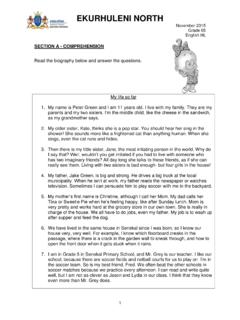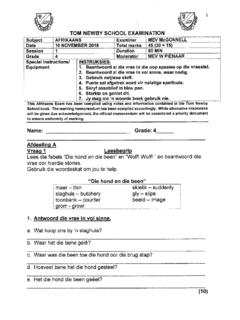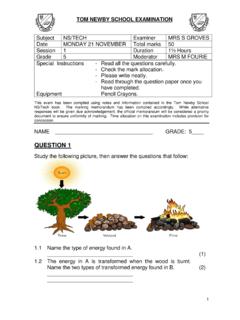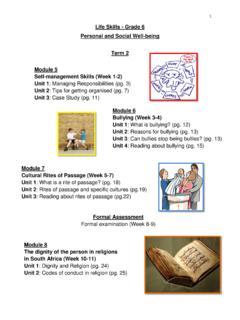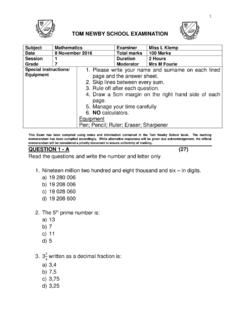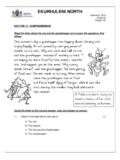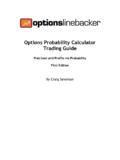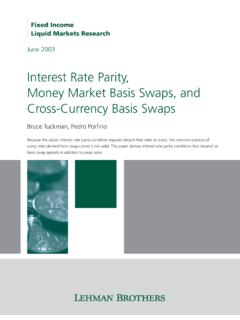Transcription of TOM NEWBY SCHOOL EXAMINATION
1 1 TOM NEWBY SCHOOL EXAMINATION Subject EMS Examiner Miss L Klemp/Miss B Botha Date 16 November 2016 Total marks 150 Session 1 Duration 2 hours Grade 7 Moderator Mrs A Singh Special instructions/ Equipment 1. Ensure your name and surname are on each page of your answer book. 2. Read the instructions for each question. 3. Skip lines between your answers. 4. Rule off after each question. 5. Number your answers exactly as they are numbered in the question paper. 6. You will be allowed to use a calculator. No sharing of a calculator is allowed. This paper is made up of FOUR questions. Answer all questions on the answer book only. This Exam has been compiled using notes and information contained in the Tom NEWBY SCHOOL book. The marking memorandum has been compiled accordingly. While alternative responses will be given due acknowledgement, the official memorandum will be considered a priority document to ensure uniformity of marking.
2 QUESTION 1 (40) 1. Match the terms in Column A with the definitions in Column B Example (1 a) . Column A Column B 1. Negotiation 2. Bartering 3. Currency 4. Credit 5. Electronic banking 6. Self-sufficient a) Money in any form, issued by a government of a country. b) Produce goods and service for own use. c) Cheque book d) Bargaining process between groups or individuals. e) Get goods and services before you pay for them. f) Exchanging goods and services without using money. g) Transfer of funds between banks through electronic means. (12) 2 2. Use the following words to complete the sentences below: Community tertiary promissory note secondary unlimited manufacturing limited a) A business that makes tyres is a producer in the _____ Sector of the economy. b) A _____ is a written promise to pay an amount of money. c) _____ resources means that there are fixed amounts of raw materials, labour and money.
3 D) Healthcare, good quality housing and education are all basic needs of a _____. (4) 3. List four features of a traditional society. (4) 4. Explain the effect of a natural disaster on an informal business. (3) 5. List 3 ways in which a health epidemic can affect a formal business? (3) 6. Briefly explain the difference between goods and services and provide an example of each. (4) 7. State whether the following statements are TRUE or FALSE. (10) a) Communities and countries have basic needs that have to be met in order for them to survive. b) Capital resources are things that people make to satisfy our needs and wants. c) Economic goods are goods such as air and sunlight. d) Trading businesses buy and sell goods. e) Households are the only consumers of goods and services. f) Durable goods are goods that wear out quickly. g) Money is an example of a limited resource.
4 H) Cowrie shells were used as the first form of money. i) An epidemic is a disease that spreads rapidly. j) Modern societies are self-sufficient. 3 QUESTION 2 (40) 1. Match Column A to Column B. Example (1- b) Column A Column B 1. Debt that is repaid over a period longer than one year. 2. The part of a person s income that is not spent, but is kept for future use. 3. Money needed to start a business. 4. Receipts, bank deposit slips and invoices. 5. Assets that can be converted into cash within a year. 6. A plan of how expected expenses for the next month will be paid with the available income for the month. a) Capital b) Source documents c) Financial Records d) Bank e) Budget f) Drawings g) Savings h) Non-current liabilities i) Fixed assets j) Current assets k) Transaction (12) 2. This is a list of Bill Murray s assets and liabilities on 31 October 2016: He owes R50 to the Tom NEWBY SCHOOL tuck shop.
5 He has a mountain bike valued at R12 000. He has clothes to the value of R4 500. He owes his mother R220, for which he borrowed, to buy his friend a birthday gift. His last ATM slip indicated that he had R340 in his account. He received an account from the local bicycle shop for R2 120, for repairs to his bicycle. He has an expensive badminton racket worth R1 000. He owns a cellphone worth R2 000. He still owes R580 on his clothing account. Compile a statement of Net Worth and calculate Bill s current net worth. (12) 3. Name 3 types of Capital. (3) 4. Explain what the profit motive of a business is. (2) 5. Name 3 people or institutions who would be interested in the financial statements of a business. (3) 4 6. Are the following, Assets or Liabilities? a) Building b) Telephone account c) Money in a Savings Account d) Machinery e) Rental account for a storeroom.
6 (5) 7. Provide definitions for the following terms: a) Profit b) Loss c) Capital (3) _____ QUESTION 3 (30) 1. Read the following case study and answer the questions that follow: Tom van Niekerk is 12 years old. When his aunt and uncle moved into a smaller home a year ago, they had to sell a lot of their furniture, but weren t sure how to go about it. Tom suggested that they sell it on eBay, an online auction service, and offered to do it for them for a small commission. They readily agreed as their computer skills were not very good and, because they were busy with renovations on the new house they did not have the time do it themselves. Tom sold the furniture in no time at all and presented his aunt and uncle with R12 000 for their furniture! They were delighted and gave him 10% of what they had made. Tom now had R1 200 in his bank account.
7 Instead of buying something with the money, he decided to invest it in his new business. He realised that many of his parents friends had garages and attics full of things that they did not want. Tom spread the word that he would take any articles in good condition and sell them for a commission. He decided that besides selling goods on eBay, he would also sell at the markets and car boot sales. So, once a month, Tom set up a table at a car boot sale that took place in his neighbourhood. He priced his items to sell quickly as he did not want to build up too much stock. While at the car boot sale he noticed that there were many bargains to be had and he bought a few items, which he then sold on for a small profit. His sister, Chloe, was good at making fudge and, once a month, she supplied Tom with packets of fudge to sell at the car boot sale. Now, Tom has a small storeroom at his parents house where he keeps his stock of goods.
8 He sells his stock from home, on eBay and at the car boot sale, once a month. The money he earns is steadily growing! 5 a) Why can we call Tom an entrepreneur? Give an explanation and a reason from the case study. (4) b) Explain the word and phrase below: A. commission (1) B. price items to sell (1) c) Provide examples, from the case study, to illustrate the entrepreneurial actions of: A. Buying (1) B. Selling (1) C. Producing (1) D. Making a profit (1) d) What is a SWOT analysis? (4) e) Give an example of each element of the SWOT analysis from the case study. (4) 2. Successful businesses study consumer behaviour. Name 4 behaviours that these studies have shown about customers. (4) 3. State the Principles of Advertising using the AIDA principle. (4) 4. Name two advantages and disadvantages of being an entrepreneur.
9 (4) _____ QUESTION 4 (40) 1. Read the extract from City Press and answer the following questions: NEDBANK is getting kids to save! The best way to teach a person how to save money is to start at a young age. Nedbank launched three new accounts for children and teenagers. A. Nedbank 4me A transactional account for children under the age of 16 years. The account has no monthly management fee and it pays 2% interest yearly. 1. Requires an opening balance of R10 and parents need to go to the bank with their children to open this account. 2. The account comes with a debit card that can be used at Nedbank ATMs. 3. Cash withdrawals are free for the first R100 and a R1 charge on 25 transactions thereafter. 4. Mobile banking to check balances as well as SMS notifications are free. 6 B. Dezign Student Current Account A current account designed for teenagers between the ages of 16 and 18 years. As teens are more likely to make transactions, the account has a monthly management fee, which includes certain transaction costs.
10 1. Minimum of R20 needed to open this type of account. 2. A R16,50 monthly fee with unlimited withdrawals. 3. Free SMS notification service, internet and mobile banking and till points. 4. The account comes with a debit card. 5. This account pays no interest, as it is a transactional account. 6. Teenagers are encouraged to transfer their savings to the Nedbank4save account if they want to earn interest. C. Nedbank4save Available for any child up to 18 years. This account is opened separately and you can name the account after your savings goal for example iPad or car . 1. Pays 4% interest on balances and the 4% is paid from the first rand. 2. There are no monthly fees, which makes it the best short-term savings product on the market for children. 3. The parents must give a 24-hour notice to the bank to get access to the money in the savings account and the money will be paid over to the transactional account (as noted in B).
